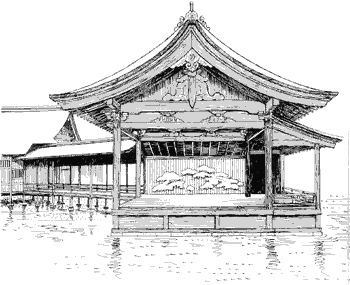

Kan'ami (1333-1384) and his son Zeami (1363-1443) were in essence the founders of the No theater. They combined elements both foreign and native, aristocratic and plebian into a sophisticated form of art. Given entrance to the highest social circles in Kyoto, these two men elevated No to a dramatic art of great beauty. It is a theater of symbolism, employing highly stylized manners of speech and movement. By the fourteenth century No was immensely popular with all levels of the population. In the Momoyama period, warrior aristocrats particular built No stages in their mansions for private viewing. Early No stages were open-air affairs that were roofed but not walled. A fine example of such a stage is the North No stage at the Shoin of Nishi Honganji, which bears the date 1581 and is the oldest No stage extant. By the Momoyama period, the No was also being performed on indoor stages. The Nishi Honganji temple in Kyoto has two such stages, one each in the Audience Hall and in the Shiroshoin.
|
|